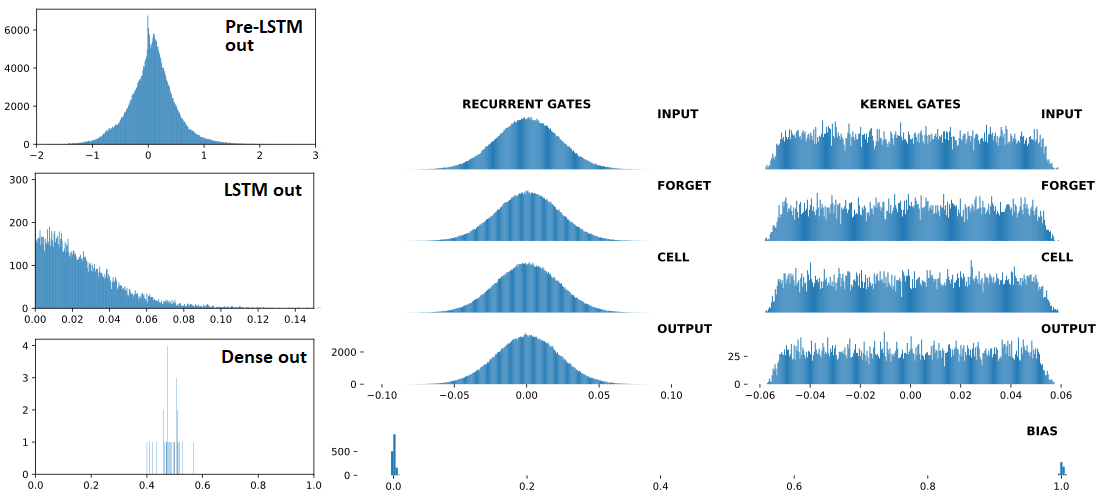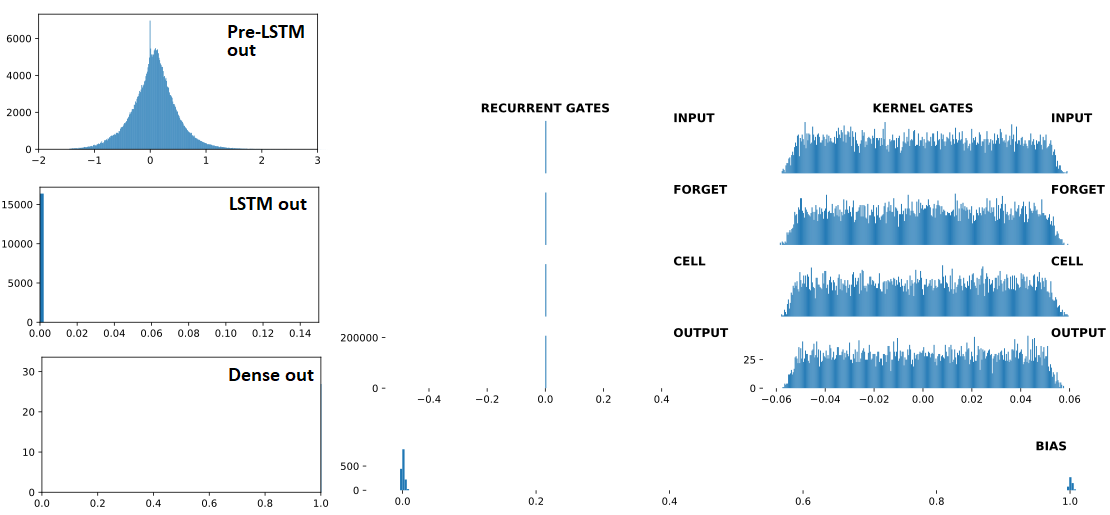LSTM 'recurrent_dropout' with 'relu' yields NaNs
Any non-zero recurrent_dropout yields NaN losses and weights; latter are either 0 or NaN. Happens for stacked, shallow, stateful, return_sequences = any, with & w/o Bidirectional(), activation='relu', loss='binary_crossentropy'. NaNs occur within a few batches.
Any fixes? Help's appreciated.
TROUBLESHOOTING ATTEMPTED:
recurrent_dropout=0.2,0.1,0.01,1e-6kernel_constraint=maxnorm(0.5,axis=0)recurrent_constraint=maxnorm(0.5,axis=0)clipnorm=50(empirically determined), Nadam optimizeractivation='tanh'- no NaNs, weights stable, tested for up to 10 batcheslr=2e-6,2e-5- no NaNs, weights stable, tested for up to 10 batcheslr=5e-5- no NaNs, weights stable, for 3 batches - NaNs on batch 4batch_shape=(32,48,16)- large loss for 2 batches, NaNs on batch 3
NOTE: batch_shape=(32,672,16), 17 calls to train_on_batch per batch
ENVIRONMENT:
- Keras 2.2.4 (TensorFlow backend), Python 3.7, Spyder 3.3.7 via Anaconda
- GTX 1070 6GB, i7-7700HQ, 12GB RAM, Win-10.0.17134 x64
- CuDNN 10+, latest Nvidia drives
ADDITIONAL INFO:
Model divergence is spontaneous, occurring at different train updates even with fixed seeds - Numpy, Random, and TensorFlow random seeds. Furthermore, when first diverging, LSTM layer weights are all normal - only going to NaN later.
Below are, in order: (1) inputs to LSTM; (2) LSTM outputs; (3) Dense(1,'sigmoid') outputs -- the three are consecutive, with Dropout(0.5) between each. Preceding (1) are Conv1D layers. Right: LSTM weights. "BEFORE" = 1 train update before; "AFTER = 1 train update after
BEFORE divergence:

AT divergence:

## LSTM outputs, flattened, stats
(mean,std) = (inf,nan)
(min,max) = (0.00e+00,inf)
(abs_min,abs_max) = (0.00e+00,inf)
AFTER divergence:

## Recurrent Gates Weights:
array([[nan, nan, nan, ..., nan, nan, nan],
[ 0., 0., -0., ..., -0., 0., 0.],
[ 0., -0., -0., ..., -0., 0., 0.],
...,
[nan, nan, nan, ..., nan, nan, nan],
[ 0., 0., -0., ..., -0., 0., -0.],
[ 0., 0., -0., ..., -0., 0., 0.]], dtype=float32)
## Dense Sigmoid Outputs:
array([[1., 1., 1., 1., 1., 1., 1., 1., 1., 1., 1., 1., 1., 1., 1., 1.,
1., 1., 1., 1., 1., 1., 1., 1., 1., 1., 1., 1., 1., 1., 1., 1.]], dtype=float32)
MINIMAL REPRODUCIBLE EXAMPLE:
from keras.layers import Input,Dense,LSTM,Dropout
from keras.models import Model
from keras.optimizers import Nadam
from keras.constraints import MaxNorm as maxnorm
import numpy as np
ipt = Input(batch_shape=(32,672,16))
x = LSTM(512, activation='relu', return_sequences=False,
recurrent_dropout=0.3,
kernel_constraint =maxnorm(0.5, axis=0),
recurrent_constraint=maxnorm(0.5, axis=0))(ipt)
out = Dense(1, activation='sigmoid')(x)
model = Model(ipt,out)
optimizer = Nadam(lr=4e-4, clipnorm=1)
model.compile(optimizer=optimizer,loss='binary_crossentropy')
for train_update,_ in enumerate(range(100)):
x = np.random.randn(32,672,16)
y = np.array([1]*5 + [0]*27)
np.random.shuffle(y)
loss = model.train_on_batch(x,y)
print(train_update+1,loss,np.sum(y))
Observations: the following speed up divergence:
- Higher
units(LSTM) - Higher # of layers (LSTM)
- Higher
lr<< no divergence when<=1e-4, tested up to 400 trains - Less
'1'labels << no divergence withybelow, even withlr=1e-3; tested up to 400 trains
y = np.random.randint(0,2,32) # makes more '1' labels
UPDATE: not fixed in TF2; reproducible also using from tensorflow.keras imports.
Studying LSTM formulae deeper and digging into the source code, everything's come crystal clear.
Verdict: recurrent_dropout has nothing to do with it; a thing's being looped where none expect it.
Actual culprit: the activation argument, now 'relu', is applied on the recurrent transformations - contrary to virtually every tutorial showing it as the harmless 'tanh'.
I.e., activation is not only for the hidden-to-output transform - source code; it operates directly on computing both recurrent states, cell and hidden:
c = f * c_tm1 + i * self.activation(x_c + K.dot(h_tm1_c, self.recurrent_kernel_c))
h = o * self.activation(c)

Solution(s):
- Apply
BatchNormalizationto LSTM's inputs, especially if previous layer's outputs are unbounded (ReLU, ELU, etc)- If previous layer's activations are tightly bounded (e.g. tanh, sigmoid), apply BN before activations (use
activation=None, then BN, thenActivationlayer)
- If previous layer's activations are tightly bounded (e.g. tanh, sigmoid), apply BN before activations (use
- Use
activation='selu'; more stable, but can still diverge - Use lower
lr - Apply gradient clipping
- Use fewer timesteps
More answers, to some remaining questions:
- Why was
recurrent_dropoutsuspected? Unmeticulous testing setup; only now did I focus on forcing divergence without it. It did however, sometimes accelerate divergence - which may be explained by by it zeroing the non-relu contributions that'd otherwise offset multiplicative reinforcement. - Why do nonzero mean inputs accelerate divergence? Additive symmetry; nonzero-mean distributions are asymmetric, with one sign dominating - facilitating large pre-activations, hence large ReLUs.
- Why can training be stable for hundreds of iterations with a low lr? Extreme activations induce large gradients via large error; with a low lr, this means weights adjust to prevent such activations - whereas a high lr jumps too far too quickly.
- Why do stacked LSTMs diverge faster? In addition to feeding ReLUs to itself, LSTM feeds the next LSTM, which then feeds itself the ReLU'd ReLU's --> fireworks.
UPDATE 1/22/2020: recurrent_dropout may in fact be a contributing factor, as it utilizes inverted dropout, upscaling hidden transformations during training, easing divergent behavior over many timesteps. Git Issue on this here
- Printing model summaries for rllib models
- TensorFlow data loader from generator error "Dataset had more than one element"
- How does argmax work when given a 3d tensor - tensorflow
- Is using batch size as 'powers of 2' faster on tensorflow?
- ModuleNotFoundError: No module named 'numpy.core._multiarray_umath' (While installing TensorFlow)
- CUDA_ERROR_NOT_INITIALIZED on A100 after server reset
- Select TensorFlow op(s), included in the given model, is(are) not supported by this interpreter. when trying load the model in flutter
- import tensorflow statement crashes or hangs on macOS
- VS Code / Pylance / Pylint Cannot resolve import
- What is the logic of the extra columns in Tensorflow categorical encoding?
- How do I format my a tensorflow dataset for a multi output model?
- TensorFlow libdevice not found. Why is it not found in the searched path?
- neural network - Predict MNIST digits only with one neuron in the output layer
- What is regularization loss in tensorflow?
- Incorrect header check error when trying to access a tf_record file
- How can I get the number of CUDA cores in my GPU using Python and Numba?
- keras 2.4. producing completely different output than 2.3.1
- How to extract the hidden vector (the output of the ReLU after the third encoder layer) as the image representation
- Why does my MNIST dataset model only get an accuracy of around 11%?
- Changing MobileNet Dropout After Loading
- Augment MNIST dataset tensorflow
- TF Lite shows only zeros on prediction
- tensor board output is not shown when I am trying to run the jupyter notebook on VSC
- Why is numpy native on M1 Max greatly slower than on old Intel i5?
- Faster Kmeans Clustering on High-dimensional Data with GPU Support
- Confused about how tf.keras.Sequential works in TensorFlow – especially activation and input_shape
- ModelCheckpoint not saving the hdf5 file
- module 'keras.utils.generic_utils' has no attribute 'get_custom_objects' when importing segmentation_models
- Difference between Tensorflow/Keras Dense Layer output and matmul operation with weights with NumPy
- Tensorflow import error: No module named 'tensorflow'